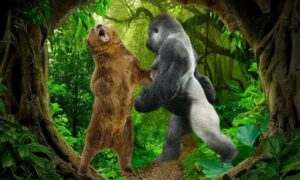In the animal kingdom, few comparisons ignite as much curiosity as the showdown between a gorilla and a polar bear. These two incredible creatures symbolize power, endurance, and dominance in their respective habitats. But when it comes to sheer size, which animal reigns supreme?
Polar bears are much bigger than gorillas. Male polar bears are some of the largest meat-eating animals that live on land. They weigh a lot more and are taller and longer than gorillas.
Whether you’re a wildlife enthusiast, a curious student, or someone who loves epic animal comparisons, this article breaks down everything you need to know about gorillas vs. polar bears covering size, weight, habitat, muscle mass, and more. By the end, you’ll have a crystal-clear answer to the age-old question: who is truly larger?
Gorilla vs. Polar Bear: Key Differences Made Simple

Size: Gorilla vs. Polar Bear who is larger. A full-grown male polar bear can weigh over 1,000 pounds, while a male gorilla usually weighs around 400 pounds.
What They Eat: Gorillas stick to plants. They love fruits, leaves, and stems. Polar bears, on the other hand, are meat-eaters. They mainly hunt seals and other animals in the wild Arctic.
Face Shape: Gorillas have strong faces with big brow ridges and flat noses. Polar bears have longer, more pointed snouts and small round ears, built for cold weather.
Gorilla vs. Polar Bear: Quick Comparison Table
| Feature | Gorilla | Polar Bear |
|---|---|---|
| Average Height | 4.5–6 feet (standing) | 7.25–8 feet (standing) |
| Average Weight | 300–485 lbs (male) | 900–1,600 lbs (male) |
| Shoulder Height | 5.5 feet (on all fours) | 4–5.3 feet (on all fours) |
| Body Length | 5.5 feet | 7.25–10 feet |
| Muscle Mass | Very high | High |
| Diet Type | Primarily herbivore | Carnivore |
| Habitat | Tropical forests (Africa) | Arctic regions (Canada, Russia) |
Understanding the Gorilla: Size and Strength in the Jungle
Physical Dimensions
The eastern lowland gorilla, the largest of the gorilla subspecies, is massive yet still dwarfed by some of its bear counterparts.
- Height: Typically 5.5 to 6 feet when standing.
- Weight: Adult male gorillas (silverbacks) weigh between 300 to 485 pounds.
Arm Span: Up to 8.5 feet.
- Muscle Mass: Extremely muscular; about 40% of a gorilla’s body is pure muscle.
Despite their strength and intimidating build, gorillas are gentle giants. They live in family groups and spend their days foraging for fruits, leaves, and bamboo shoots.
Strength to Size Ratio
Gorillas are known to be up to 10 times stronger than the average human, thanks to their dense muscle fibers and barrel-shaped torsos. However, their strength is more about leverage than raw bulk.
Meet the Polar Bear: Arctic Giant of the Ice
Physical Dimensions
The polar bear (Ursus maritimus) holds the title of the largest land carnivore on Earth.
- Height: Up to 8 feet tall when standing on hind legs.
- Weight: Adult males average between 900 and 1,600 pounds; females are smaller.
- Length: From nose to tail, about 7.25 to 10 feet.
- Shoulder Height (on all fours): About 4 to 5.3 feet.
- Fur and Fat Layers: Thick insulating fur and a 4.5-inch fat layer for Arctic survival.
Survival Machine
Built for survival in the harshest environments, polar bears are apex predators. They primarily hunt seals and have adapted to cover vast ice terrains with efficiency.
Comparing Their Sizes in Detail
- Body Weight: No Contest
- Polar Bear: Average adult males weigh more than double a male gorilla.
- Gorilla: Even the heaviest silverback rarely crosses 500 pounds.
➡️ Winner: Polar Bear
Height and Length
While gorillas can stand tall, they lack the extended body length of polar bears.
- Standing Height: Polar bears easily stand over 7 feet.
- Body Length: Polar bears stretch much longer than gorillas.
➡️ Winner: Polar Bear
Muscle Density and Strength
- Gorilla: Exceptionally dense muscles, with short bursts of intense power.
- Polar Bear: Still strong, but more reliant on endurance and body mass.
➡️ Winner: Gorilla in raw strength-to-size ratio, but polar bear wins in size and bulk strength.
Why Do People Compare Gorillas and Polar Bears?
Here are some common reasons this comparison arises:
- Pop Culture: Featured in movies, comics, and hypothetical battles.
- Curiosity: Fascination with which animal is more powerful.
- Educational: Helps illustrate concepts of size, adaptation, and evolution.
Real-World Examples and Fun Facts
Real-Life Observations
- A polar bear in captivity once weighed over 2,200 pounds, making it more than four times heavier than the average silverback.
- Gorillas can lift up to 1,800 pounds in controlled experiments nearly 10 times their body weight.
Interesting Facts
- Polar bears have black skin under their white fur to absorb sunlight.
- Gorillas share 98.3% of human DNA, making them our closest cousins after chimpanzees.
Real-World Examples and Fun Facts
Real-Life Observations
- A polar bear in captivity once weighed over 2,200 pounds, making it more than four times heavier than the average silverback.
- Gorillas can lift up to 1,800 pounds in controlled experiments nearly 10 times their body weight.
Interesting Facts
- Polar bears have black skin under their white fur to absorb sunlight.
- Gorillas share 98.3% of human DNA, making them our closest cousins after chimpanzees.
Habitat and Adaptation Differences
Gorillas
- Location: Central Africa
- Climate: Warm, tropical
- Lifestyle: Live in troops, highly social
- Diet: Herbivorous
Polar Bears
- Location: Arctic Circle (Canada, Alaska, Russia, Norway, Greenland)
- Climate: Extreme cold
- Lifestyle: Solitary
- Diet: Carnivorous, mainly seals
Frequently Asked Questions
Who Would Win in a Fight?
While gorillas are stronger pound-for-pound, polar bears are much larger and more equipped for combat, especially with their sharp claws and massive jaws. In most hypothetical encounters, the polar bear would have the upper hand due to its size, weight, and natural predatory instincts.
Are There Bigger Gorillas?
The eastern lowland gorilla is the largest known gorilla subspecies, but even it doesn’t come close to matching a polar bear’s mass.
Could a Gorilla Survive in the Arctic?
Highly unlikely. Gorillas are adapted to tropical environments and would not fare well in cold, isolated regions like the Arctic.
Visual Suggestions
To break up the content and improve user engagement, consider including the following images:
- Size Comparison Chart: Visual bar graph showing average weights and heights.
- Side-by-Side Image: Gorilla and polar bear standing upright with height markers.
- Muscle Comparison Diagram: Highlighting muscle density vs. body fat.
- Habitat Map: Showing native regions of both animals.
Alt Text for Images Example:
“Side-by-side comparison of an adult male gorilla and polar bear, showing size difference in height and weight.”
Conclusion: The Final Verdict
When it comes to sheer size, the polar bear is the undisputed champion. With a body weight that can exceed 1,600 pounds, a towering height of up to 10 feet, and physical adaptations that allow it to dominate the frozen north, the polar bear easily surpasses the gorilla in size metrics.
However, that doesn’t diminish the awe-inspiring power of the gorilla, which remains one of the strongest primates on Earth, admired for its intelligence, strength, and family dynamics.
In summary:
- Larger in size? ✅ Polar Bear
- Stronger pound-for-pound? ✅ Gorilla
- More massive and powerful overall? ✅ Polar Bear
Whether you’re team gorilla or team polar bear, one thing’s for sure both animals are evolutionary marvels worthy of admiration.

